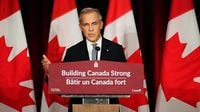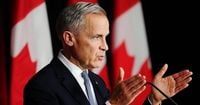Canadian Prime Minister Mark Carney delivered a striking address to the nation on October 22, 2025, signaling a seismic shift in Canada’s economic and diplomatic posture toward its southern neighbor. Speaking to students in Ottawa, Carney did not mince words as he described the end of an era: the once-unquestioned closeness between Canada and the United States has, in his view, become a source of vulnerability rather than strength.
“This decades-long process of an ever-closer economic relationship with the United States is now over. And as a consequence, many of our former strengths as a country—more particularly, our economic strengths based on close ties to America—have now become our vulnerabilities,” Carney declared, according to reporting by The Independent and other outlets. His message was clear: the foundation of Canada’s prosperity, built on open trade and neighborly cooperation, is under threat from a new wave of American protectionism and unpredictability.
Carney’s remarks come on the heels of a series of aggressive moves by U.S. President Donald Trump, whose “America First” doctrine has resulted in the imposition of tariffs on key Canadian exports such as steel, aluminum, lumber, and autos. These measures, Carney said, have cast a pall of uncertainty over the Canadian economy, with businesses hesitant to invest and workers in vital industries feeling the squeeze. “The jobs of workers in our industries most affected by US tariffs—autos, steel, lumber—are under threat. Our businesses are holding back investments, restrained by the pall of uncertainty that is hanging over all of us,” Carney stated.
The Canadian prime minister did not shy away from criticizing Trump’s rhetoric, particularly the inflammatory suggestion that Canada could become the “51st state.” Carney described such comments as threats to Canada’s economy and sovereignty, underscoring a broader trend of deteriorating trust and goodwill between the two countries. “The US has fundamentally changed its approach to trade, raising its tariffs to levels last seen during the Great Depression,” he noted. The message was unmistakable: Canada can no longer afford to rely on a single foreign partner, no matter how close the historical relationship.
In response, Carney outlined a bold new direction for Canadian policy. “Now, above all, we will build Canadian,” he told his audience. The government’s upcoming budget, set for release on November 4, will prioritize a “Buy Canadian” approach—favoring domestic steel, aluminum, lumber, manufactured goods, and technology for Canadian projects. This shift aims to insulate the nation from external shocks and foster a greater measure of economic self-reliance. “We have to take care of ourselves, because we can’t rely on one foreign partner. We have to take care of each other because we are stronger together,” Carney emphasized.
But Carney’s vision extends beyond simply reducing dependence on the United States. He announced an ambitious goal for Canada to double its non-U.S. exports within the next decade, a strategy designed to diversify trade and open new markets for Canadian goods and services. “We are re-engaging with the global giants India and China,” Carney revealed, pointing to a future where Canada’s economic fortunes are not tied so tightly to a single neighbor.
This recalibration comes at a time when Canada’s vital economic statistics remain deeply intertwined with those of the U.S. Canada is the top export destination for 36 U.S. states, and nearly 3.6 billion Canadian dollars (about 2.7 billion USD) worth of goods and services cross the border every day. The two countries’ free trade agreement is scheduled for review in 2026, adding another layer of uncertainty to an already fraught relationship.
Carney was candid about the challenges ahead. “I will always be straight about the challenges we have to face and the choices we must make,” he said. “To be clear, we won’t transform our economy easily or in a few months—it will take some sacrifices and some time.” This honesty is rooted in the stark reality that tariffs and trade tensions are already having a chilling effect on investment, particularly in sectors like autos, steel, and lumber, where Canadian jobs are most at risk.
Still, Carney believes Canada has significant assets to leverage. Calling the country an “energy superpower,” he highlighted that Canada possesses the third-largest reserves of oil and the fourth-largest reserves of natural gas in the world. The U.S. relies heavily on Canada for its energy needs, importing 60% of its crude oil and 85% of its electricity from north of the border. Canada is also the largest foreign supplier of steel, aluminum, and uranium to the U.S., and boasts 34 critical minerals and metals that are vital to American national security.
Yet, even these strengths have become double-edged swords in the current climate. What was once a mutually beneficial arrangement is now a source of leverage and, potentially, friction. Carney’s remarks reflect a growing consensus among Canadian leaders that the country must prepare for a world where U.S. policy is more erratic and self-interested than at any time in recent memory.
To bolster Canada’s resilience, Carney also announced the largest investments in the country’s military in generations, a move prompted by new security threats and the recognition that Canada can no longer take its alliances for granted. “The new security threats reaching our shores mean we’re making the biggest investments in our military in generations. But up until now, more than 70 cents of every dollar of military capital spending by our government has gone to the U.S.,” he said, signaling a coming shift toward greater domestic procurement and capability.
Carney’s pivot is not occurring in a vacuum. Across Europe and other parts of the world, traditional U.S. allies are rethinking their relationships with Washington, wary of the unpredictability and transactional nature of Trump-era diplomacy. For Canada, this moment marks a turning point—a chance to redefine its place in the world, assert its sovereignty, and chart a more independent course.
As the November 4 budget announcement approaches, all eyes will be on how Carney’s government intends to put these words into action. The stakes are high, and the path forward is uncertain. But one thing is clear: the era of unquestioned Canadian reliance on the United States is over, and a new chapter in the country’s economic and political story is just beginning.





